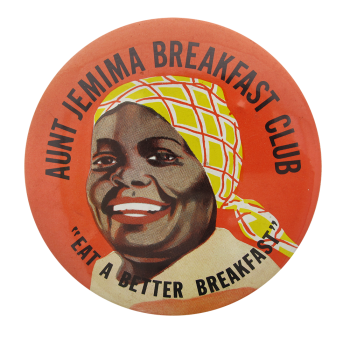| Category | |
|---|---|
| Additional Images | |
| Sub Categories | |
| Text on Button | AUNT JEMIMA BREAKFAST CLUB - "EAT A BETTER BREAKFAST" |
| Image Description | Color illustration of a smiling woman with a colorful scarf tied around her head on an orange background. Black text wraps around the top and bottom of the button. |
| Back Style | |
| The Shape | |
| The Size | |
| Year / Decade Made | |
| The Manufacturer | |
| Additional Information | Aunt Jemima pancake flour was introduced in 1889 as an early ready-mix product, named after a minstrel-show song, “Old Aunt Jemima.” R.G. Davis acquired the recipe and mill, transforming it into a national brand by creating a persona: Nancy Green portrayed “Aunt Jemima” at the 1893 World’s Columbian Exposition, with a folksy plantation backstory that boosted sales. Much of the memorabilia, such as “Breakfast Club” buttons and recipe pamphlets, was produced by Adcraft Mfg. Co. of Chicago. Aunt Jemima memorabilia is considered offensive because it markets a racist caricature. The brand’s mascot grew out of 19th-century minstrelsy and the “mammy” stereotype: a smiling, head-scarved Black woman portrayed as happily serving white families. Using “Aunt” (instead of “Mrs.”) echoed Jim Crow–era norms that denied Black women equal respect. Ads and premiums often leaned on plantation nostalgia and dialect, trivializing slavery and domestic servitude while turning a demeaning image into cheerful kitchen décor. These items also exploited and erased the real Black women hired to embody the character, who were rarely credited or fairly compensated, while the company profited from their likeness. Because the imagery appeared on everyday objects—boxes, signs, club buttons—it normalized the stereotype for generations. That long, harmful history is why the brand was repeatedly criticized and why the name and logo were ultimately retired. |
| Sources |
Alcorn, C. (2021, February 9). Aunt Jemima finally has a new name. CNN. Retrieved October 24, 2025, from https://www.cnn.com/2021/02/09/business/aunt-jemima-new-name Diaz, J. (2021, February 10). Aunt Jemima no more; pancake brand renamed Pearl Milling Company. NPR. Retrieved October 24, 2025, from https://www.npr.org/2021/02/10/966166648/aunt-jemima-no-more-pancake-brand-renamed-pearl-milling-company#:~:text=Origin%20of%20Pearl%20Milling%20Company,hit%20store%20shelves%20in%20June Jim Crow Museum. (n.d.). The mammy caricature. Retrieved October 23, 2025, from https://jimcrowmuseum.ferris.edu/mammies/homepage.htm McNamee, G. L. (2025, January 21). Aunt Jemima (Pearl Milling Company). Encyclopaedia Britannica. Retrieved October 25, 2025, from https://www.britannica.com/topic/Aunt-Jemima-Pearl-Milling-Company National Museum of African American History and Culture. (n.d.). Popular and pervasive stereotypes of African Americans. Smithsonian. Retrieved October 23, 2025, from https://nmaahc.si.edu/explore/stories/popular-and-pervasive-stereotypes-african-americans Old Aunt Jemima. (2025, June 16). In Wikipedia. Retrieved October 24, 2025, from https://en.wikipedia.org/wiki/Old_Aunt_Jemima Reilly, K. (2020, June 17). Quaker Oats: Aunt Jemima brand is ‘based on racial stereotype,’ will change name and packaging. Time. Retrieved October 23, 2025, from https://time.com/5854935/aunt-jemima-syrup-racial-stereotype/ |
| Catalog ID | AD0384 |


